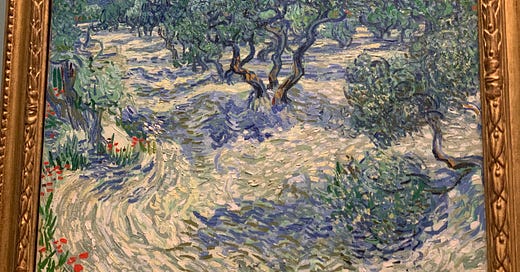Van Gogh at the National Gallery, London
The National Gallery’s Van Gogh exhibition is exhilarating and lush. When the blurb mentioned poetry from letters, I thought most of the exhibits would be dusty letters translated on placards outside glass cases. How wrong I was. The exhibition is chock full of beautiful paintings, with a sprinkling of drawings (the latter only take up one of many rooms.) The poetry, such as it is, consists of heartfelt lines lifted from the master’s letters, painted on the walls. His earnest, deeply perceptive quotes complement the visual art.
The work is taken from the last two years of Van Gogh’s life, 1888- 1890, when he moved to the South of France, living in Arles and Saint-Rémy de Provence. The Southern light suited him - this was an immensely fertile creative period for the Dutch artist. In regular letters to his brother Theo, he shared his vision and hopes.
Gardens were a source of inspiration for the artist. In Arles, he lived near a large public garden, and when hospitalised, he found joy in the garden of Saint-Paul de Mausole at Saint-Rémy-de-Provence.
The first room showcases these verdant creations. We see the trees of the public garden depicted in various seasons - autumnal russets and fresh spring greens. Like Matisse and the Fauves, Van Gogh did not stick to ‘realistic’ colours but used glorious bright shades which lifted the paintings - blues and turquoises as well as yellow, brown and greens. His ability to render texture through differing brushstrokes is striking, soft whorls of leaves contrasting with spikier bushes and the bristles of fir trees. Pale pink blobs of paint represent roses in a lifelike way that defies the lack of structure; Van Gogh was such a genius at evoking impressions that I almost wanted to draw close and inhale the blooms.



